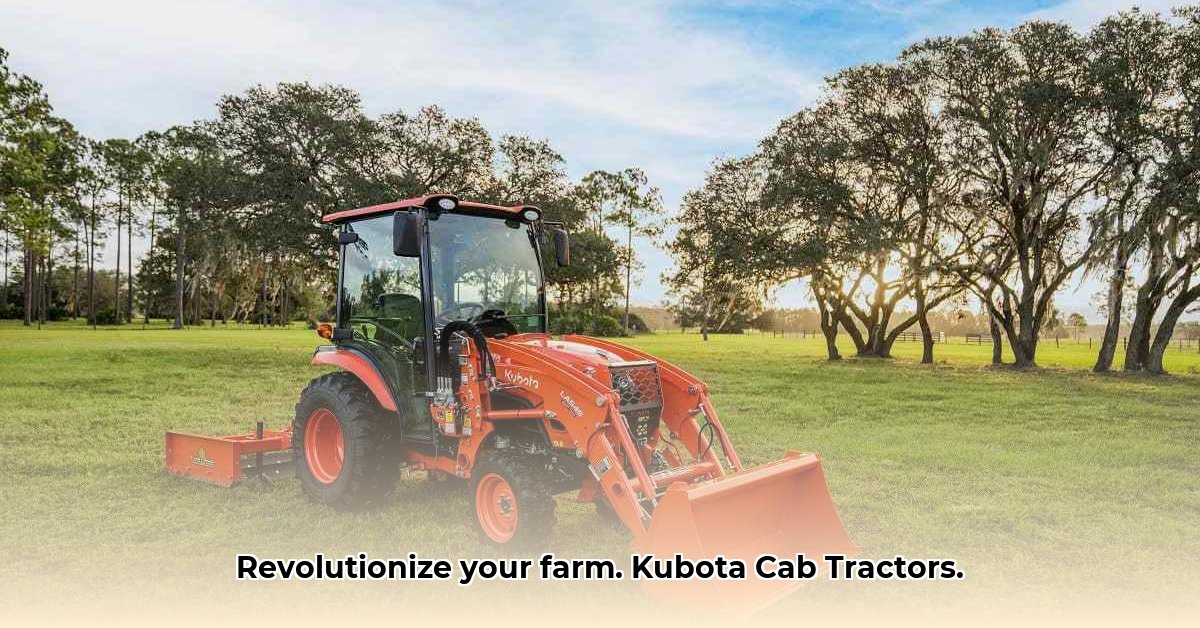
Choosing the right tractor is a crucial decision for any farmer. It's a substantial investment directly impacting your farm's productivity and profitability. Kubota cab tractors represent a smart choice for modern, sustainable agriculture, offering a compelling blend of efficiency, comfort, and technological advancement. This guide provides a practical, step-by-step approach to selecting, using, and maintaining a Kubota cab tractor to maximize your farm's potential. For more information on Kubota tractor weights, see this helpful resource: Kubota Tractor Weights.
Why Choose a Kubota Cab Tractor?
The advantages of a cab tractor extend beyond mere convenience. A climate-controlled cab protects you from harsh weather conditions, increasing comfort and reducing fatigue. This translates to improved worker morale and increased efficiency; a happier, more productive workforce directly benefits your farm's bottom line. Think of it as a mobile, climate-controlled office in the heart of your fields, maximizing your output and comfort. But what specific advantages does Kubota offer?
Kubota Cab Tractors: Features and Benefits
Kubota cab tractors are known for their reliability, power, and advanced features designed to enhance efficiency and sustainability. Let's examine key features that set them apart:
Precision Agriculture Technology: Many Kubota models integrate GPS-assisted steering and other precision agriculture tools. This promotes pinpoint accuracy in planting, fertilization, and spraying. This translates to optimized resource utilization, reduced input costs (fertilizers, pesticides, seeds), and ultimately higher crop yields.
Ergonomic Design: Intuitive controls and a comfortable operator environment minimize fatigue and maximize productivity. This enhances operational efficiency and reduces the risk of operator error, leading to improved results and reduced downtime.
Enhanced Safety Features: Kubota prioritizes safety. Rollover Protection Structures (ROPS) and other safety mechanisms protect operators from potential hazards. Investing in safety equipment protects your crew and reduces the risk of costly accidents and downtime.
Fuel Efficiency: Kubota's commitment to fuel-efficient engines directly impacts your operating costs, resulting in significant long-term savings. Lower fuel consumption translates directly to a healthier bottom line.
Versatility: Kubota tractors are highly versatile, compatible with a wide range of implements for various farming tasks, from plowing and planting to harvesting and hauling. This adaptability reduces the need for multiple specialized machines, optimizing storage and streamlining operations.
Selecting Your Kubota Cab Tractor: A Step-by-Step Guide
Selecting the ideal Kubota cab tractor requires careful consideration of several key factors:
Step 1: Assess Your Farming Operation: Analyze your farm's size, crop types, and primary farming activities. This assessment helps determine the appropriate tractor size and capabilities.
Step 2: Determine Power Requirements: Calculate your horsepower needs based on field size, implement usage, and soil conditions. Consult a Kubota dealer to determine the optimal horsepower for your specific needs.
Step 3: Set a Budget: Establish a realistic budget. Kubota offers a range of models to suit various budget constraints.
Step 4: Implement Compatibility: Ensure compatibility with your existing and planned implements.
Step 5: Choose a Reliable Dealer: Select a reputable dealer who offers strong support, maintenance, and readily available parts. A responsive dealer minimizes downtime and extends the lifespan of your investment.
Maintaining Your Kubota Tractor: A Preventative Approach
Regular maintenance is crucial for maximizing your tractor's lifespan and performance. Consider it preventative care for your most valuable farming asset.
Essential Maintenance Checklist:
Oil Changes: Adhere to the recommended oil change intervals outlined in your owner's manual. Regular oil changes prevent engine wear and prolong its lifespan.
Filter Replacements: Replace air, fuel, and hydraulic filters regularly. Clogged filters impair performance and can lead to costly repairs.
Fluid Level Checks: Monitor coolant, hydraulic fluid, and transmission fluid levels. Low fluid levels can damage vital components.
Tire Pressure: Maintain correct tire pressure for optimal traction and fuel efficiency. Under-inflated tires negatively impact fuel consumption and tire longevity.
Regular Inspections: Regularly inspect the tractor for leaks, damage, or loose parts. Early detection of minor problems prevents major repairs in the future.
Kubota Cab Tractors and Sustainable Agriculture
Kubota cab tractors, with their enhanced precision farming capabilities, contribute significantly to sustainable agricultural practices. By optimizing resource utilization and minimizing waste, they help reduce environmental impact while increasing efficiency and long-term profitability. Isn't that a win-win situation that benefits both your farm and the planet?
Precision Agriculture ROI: A Calculated Approach
While the initial investment in a Kubota tractor and precision technologies might seem substantial, the potential for significant long-term cost savings is considerable. Precision agriculture technologies, when implemented correctly, can lead to notable improvements in resource efficiency. However, careful planning and a phased approach are crucial to achieving a positive Return on Investment (ROI), particularly for smaller operations with limited resources. This requires a meticulous calculation that takes into account initial investment costs, projected cost savings from reduced input use, and a realistic timeline for recouping your investment.
Calculating ROI for Precision Agriculture (Simplified):
- Identify Needs: Pinpoint the areas where precision agriculture can make the greatest impact (e.g., fertilizer application, weed control, planting accuracy).
- Research Technology: Explore available solutions, mindful of your budget constraints. Consider leasing or renting equipment as a cost-effective starting point.
- Estimate Cost Savings: Project potential savings in inputs (fertilizer, seeds, pesticides, fuel) based on the reduction in waste and increased efficiency achieved through precision techniques.
- Calculate Initial Investment: Compile all associated costs (equipment, software, training, potential infrastructure upgrades).
- Determine ROI: Subtract total investment costs from projected cost savings over a defined period (e.g., 3-5 years). Divide the result by your total investment to express ROI as a percentage.
Remember, consistent monitoring and optimization are key to achieving significant returns. The long-term benefits of reduced environmental impact and improved sustainability should also be factored into the overall assessment. A Kubota cab tractor, because of its inherent efficiency and reliability, can contribute meaningfully to these positive outcomes.